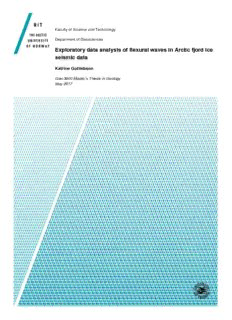
Exploratory data analysis of flexural waves in Arctic fjord ice seismic data PDF
Preview Exploratory data analysis of flexural waves in Arctic fjord ice seismic data
Faculty of Science and Technology Department of Geosciences Exploratory data analysis of flexural waves in Arctic fjord ice seismic data Katrine Gotliebsen Geo-3900 Master’s Thesis in Geology May 2017 Abstract A seismic source on floating ice induces flexural waves in the ice layer. An exploratory data analysis of Arctic fjord ice seismic data is performed for the purpose of identifying and studying characteristics of flexural waves and other related wave modes. Both geophone and hydrophone data are examined with the purpose of studying ice properties from ice wave behavior. Power spectral density estimates provide the frequency content of the entire signal, and studies of time- frequency plots have revealed both dispersive and non-dispersive ice related waves and their corresponding frequencies. F-k spectra are applied to study the dispersion relation for both flexural and acoustic ice waves. This provides the (variation in) wavelengths for the different waves. Velocities of the flexural waves are obtained by cross-correlating receivers at known offsets and by combining the obtained wavelengths with the period found from single receiver traces. Other observed waves include a guided direct wave in ice, a seafloor reflection and its multiples, and a refracted wave. The combination of several analysis methods makes it possible to identify several characteristics and properties of floating ice related waves, contributing to the understanding of such wave behavior. Wave characteristics of flexural and acoustic ice waves are combined to find ice properties like thickness and rigidity. Acknowledgement I thank my supervisor Professor Alfred Hanssen and my co-supervisor Professor Tor Arne Johansen for excellent advice, guidance and support during the work of my thesis. Further, I thank employees at the University of Bergen associated to the research project: Senior Engineer Bent Ole Ruud, ARCEx postdoc. Marcus Landschulze and ARCEx PhD Ronny Tømmerbakke, for providing the data, useful additional information to the data, advice and discussions on the topic. I also thank Rolf Andersen and Kristian Jensen for support on MATLAB issues. Furthermore, I thank all my fellow students, both from the University of Bergen and the University of Tromsø, my family and my friends for support throughout the entire study program. A special thanks to my office fellows for the past year, Suchada and Anna, for making this such a memorable time. Katrine Gotliebsen Contents 1 Introduction .................................................................................................................................. 1 1.1 Motivation for studies ............................................................................................................. 2 1.2 Previous work .......................................................................................................................... 3 1.3 Objective of thesis ................................................................................................................... 5 2 Theory ............................................................................................................................................ 7 2.1 Climate and sea ice in the Arctic ............................................................................................. 7 2.2 Wave theory ............................................................................................................................ 8 2.2.1 Phase velocity, group velocity and dispersion................................................................. 9 2.3 Mechanical and physical properties of saline ice .................................................................. 12 2.3.1 Deformation mechanisms in saline ice .......................................................................... 14 2.4 Seismic wave modes related to floating ice .......................................................................... 16 2.4.1 The flexural wave .......................................................................................................... 17 2.4.1 Receiver responses to seismic waves ............................................................................ 20 2.4.2 Wave equations for waves in viscoelastic plates ........................................................... 20 2.5 Processing and analysis of floating ice seismic data ............................................................. 22 2.5.1 The f-k domain .............................................................................................................. 23 2.5.2 The autocorrelation function ......................................................................................... 23 2.5.3 The cross-correlation function ....................................................................................... 24 2.5.4 Frequency analysis and power spectral density estimates ............................................. 24 3 Data .............................................................................................................................................. 29 3.1 The site and its surroundings ................................................................................................. 29 3.1.1 Oceanography, climate and ice cover ............................................................................ 30 3.2 Description of survey ............................................................................................................ 32 3.2.1 Receiver types ............................................................................................................... 34 3.3 Description of data ................................................................................................................ 36 4 Method ......................................................................................................................................... 39 4.1 Ice properties from autocorrelation functions ....................................................................... 39 4.2 Ice properties from cross-correlation functions ..................................................................... 40 4.2.1 Seismic interferometry .................................................................................................. 40 4.3 Frequency analysis and spectral estimates ............................................................................ 41 4.3.1 Multitaper power spectral density estimate ................................................................... 41 4.3.2 Time-frequency domain: the spectrogram ..................................................................... 43 4.4 Filtering of signals ................................................................................................................. 45 4.5 Ice properties from the dispersion relation in f-k spectra ...................................................... 46 5 Results .......................................................................................................................................... 51 5.1 Autocorrelation functions ...................................................................................................... 51 5.2 Cross-correlation functions ................................................................................................... 53 5.3 Multitaper power spectral density estimates ......................................................................... 58 5.4 Spectrograms ......................................................................................................................... 60 5.5 Filtering of signals ................................................................................................................. 65 5.6 Dispersion relation in the f-k spectrum ................................................................................. 68 5.7 Background noise measurements .......................................................................................... 76 6 Discussion and conclusions ........................................................................................................ 77 6.1 Discussion ............................................................................................................................. 77 6.2 Conclusions ........................................................................................................................... 85 6.3 Suggestions for future work .................................................................................................. 87 6.3.1 Muting in the f-k domain ............................................................................................... 87 6.3.2 Seismic interferometry and cross-correlations .............................................................. 87 6.3.3 Geophone-hydrophone combinations: transfer functions .............................................. 88 References ............................................................................................................................................ 91 Appendix A .......................................................................................................................................... 99 Young’s modulus .............................................................................................................................. 99 Poisson’s ratio ................................................................................................................................. 100 Shear modulus ................................................................................................................................. 100 Bulk modulus .................................................................................................................................. 101 Quantities of material properties ..................................................................................................... 103 Appendix B ......................................................................................................................................... 105 Equation of motion in one dimension ............................................................................................. 105 The wave equation in three dimension ........................................................................................... 109 Acoustic seismic wave equations .................................................................................................... 112 Appendix C ........................................................................................................................................ 115 Torque balance in a bent plate ........................................................................................................ 115 Flexure of a plate ............................................................................................................................ 118 Motion in viscoelastic materials ..................................................................................................... 118
Description: